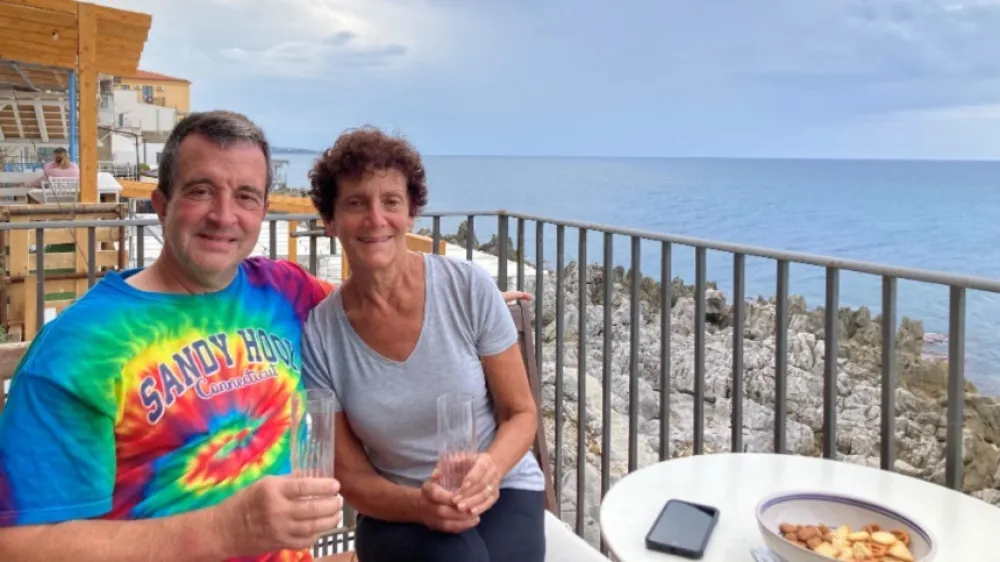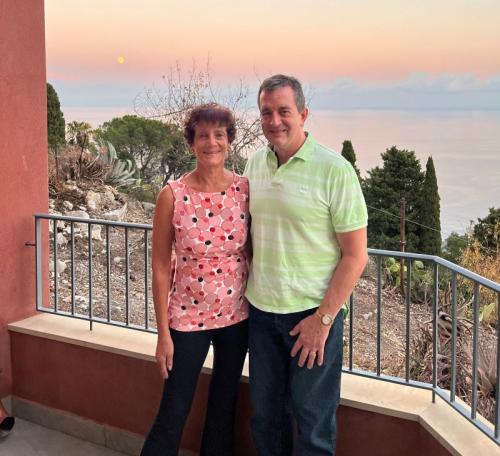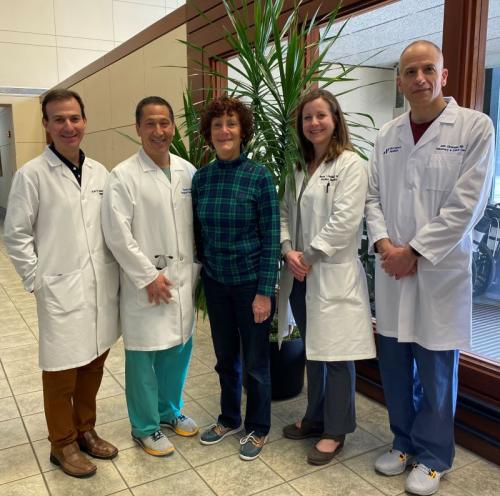Providing your location allows us to show you nearby locations and doctors.
Woman with cancer bounces back after two spine surgeries for herniated disc and bone spur

02/21/2023
Nuvance Health neurosurgeon designs the least invasive spine surgeries possible due to Randi Rote’s history of multiple myeloma, spinal stenosis and a life-threatening lung infection
“My back has been a disaster,” Randi Rote said. “I think I inherited back problems because my mom had them, too.”
Randi Rote, a 65-year old from Sandy Hook, Connecticut, has managed back problems with a positive mindset. She has managed chronic multiple myeloma with poise. She even managed a life-threatening lung infection with courage.
Find a Doctor
But in October 2021, severe leg pain took a toll on Randi’s perpetually sunny outlook.
“The pain came on quickly and it was bad,” said Randi, a retired preschool director, wife, mom of two sons and grandmother of four grandchildren.
Randi has a history of herniated discs and spinal stenosis, which is a narrowing of the spinal column that can put pressure on the nerves.
She had her first spinal fusion surgery 10 years ago. During a major eight hour surgery, she had two levels of her spine fused together from L4 and S1 vertebrae.
Randi felt better for nine years, until she started having pain in her right hip that went down to her knee. The pain made it difficult for her to be active.
“It was tough. I used to walk up to three miles a day about four days a week. But I had to stop because of the pain,” Randi said. “It got to the point where I could not live with it.”
Related article: How do I know if my back or neck pain is serious?
Battling a life-threatening lung disease
Around the same time as the leg pain, Randi had been hospitalized for a life-threatening respiratory infection.
Randi is immunocompromised from the multiple myeloma and treatments for it, which makes it more difficult for her immune system to protect her against illnesses.
Randi was having difficulty breathing and needed to use an oxygen tank. She was also losing weight and her hair.
“I could not walk 10 feet without gasping for air,” Randi said.
Randi went under the care of Dr. John Chronakos, chief of pulmonary critical care medicine at Danbury Hospital, Kerri Rossi, pulmonary APRN, and infectious disease specialist Dr. Martha DesBiens.
Randi needed a bronchoscopy to determine what was going on with her lungs. She had pneumocystis pneumonia (PJP), which is a type of lung infection that can affect people with a weak immune system.
Randi was diagnosed and treated just in time because the PJP was leading to respiratory failure.
“Thank goodness for Dr. Chronakos and everyone who figured out what was wrong with me. I could tell they really cared about me,” Randi said.
Book Now With a Pulmonologist
Getting cancer treatments for chronic multiple myeloma at Danbury Hospital
Six years ago, Randi was diagnosed with chronic multiple myeloma. Multiple myeloma is cancer that forms in a type of white blood cell called a plasma cell, which gathers in the bone marrow. Multiple myeloma can cause bone pain and weakness, particularly in the spine.
Medical oncologist Dr. Vincent Rella has been treating Randi’s cancer at the Danbury Hospital Praxair Cancer Center. Randi has three infusion treatments every month that last a half hour each time.
“Everyone single person at the cancer center is unbelievable,” Randi said.
Dr. Rella knew about Randi’s history with spine problems and the pain she was experiencing at the time. He connected her with Dr. Scott Sanderson, chief of neurosurgery at Danbury Hospital.
“Anytime I am not feeling well, Dr. Rella gets on the phone with the appropriate doctor and I see them soon after,” Randi said.
Find a Cancer Care Doctor
A herniated disc was causing unbearable leg pain
“Dr. Sanderson’s office called me on my way home from the appointment I had with Dr. Rella when I told him about my leg pain,” Randi said. “I was surprised how quickly Dr. Sanderson’s office called, which showed me he cared about my well-being without even meeting me yet. I quickly found out that he is an excellent neurosurgeon and such a nice guy.”
Related article: Do these five things before your first visit with a neurosurgeon for spine pain
“Randi had extraordinarily severe radiating leg pain and was clearly in agony when I saw her in the office,” Dr. Sanderson said.
After taking an extensive medical history and reviewing MRI scans, Dr. Sanderson determined a herniated disc at lumbar vertebrae L1–L2 was causing Randi’s pain because it was pinching nerves in her spine that went to her right, inner thigh.
“The best possible option to alleviate Randi’s pain was spine surgery because she had tried non-surgical interventions such as epidural steroid injections but the pain came back,” Dr. Sanderson said.
Related article: What type of spine surgery is right for me?
Randi had some other problems with her spine, but Dr. Sanderson first focused on fixing the issue that was causing the most pain.
“While our neurosurgeons always aim to find the least invasive way to relieve someone’s symptoms, it was especially important for Randi,” Dr. Sanderson said.
“Multiple myeloma and treatments for it affected Randi’s bone density and her body’s ability to fight infections. She had also recently been on the corticosteroid prednisone to treat PJP, which can cause weak bones. Plus, she had an extensive history of back problems and spine surgery,” Dr. Sanderson explained.
Further, the new herniated disc was two levels above the existing spinal fusion.
“The more levels that are fused together, the more stress on the spine,” Dr. Sanderson explained.
Dr. Sanderson recommended Randi have minimally invasive back surgery where he would perform two procedures: a hemilaminectomy and interspinous fusion.
Book Now with a Neurosurgeon
Having spine surgery to treat a herniated disc at New Milford Hospital
“I was not nervous before surgery because I knew I needed to get it done to feel better,” Randi said. She had surgery at New Milford Hospital, a campus of Danbury Hospital and part of Nuvance Health.
Dr. Sanderson performed the procedure through small incisions. He made space between the vertebrae with the damaged disc to relieve pressure on the nerves.
“Before surgery, Randi reacted like she was getting electrocuted when she moved and triggered the pain. After surgery, Randi said the leg pain was gone,” Dr. Sanderson said.
Randi recovered at New Milford Hospital for one day after surgery.
“Recovery was not bad at all,” Randi said. “I was up and walking soon after surgery.”
Related article: What can I expect after spine surgery?
Striking again, leg pain caused by a second spine problem
A couple months later, Randi had new pain, this time on her right, outer thigh.
Dr. Sanderson determined that a big bone spur at vertebra L3 was squishing nerves that go to the front and outside of the right thigh. Joint damage from osteoarthritis (a common cause of spinal stenosis) can cause bone spurs or calcifications.
Having lower back surgery at Danbury Hospital
Dr. Sanderson performed an extreme lateral interbody fusion (XLIF) at Nuvance Health’s Danbury Hospital, which has the latest technology for spine surgery. XLIF is a robotic image-guided surgery with nerve monitoring.
During the surgery, Dr. Sanderson went through small incisions in Randi’s side to reach the spine in order to avoid major bones, ligaments and muscles in the back.
Then, Dr. Sanderson removed the disc with the bone spur and replaced it with an implant and bone graft, which is a very strong fusion device.
Finally, Dr. Sanderson performed another minimally invasive surgery at the same time to remove the pressure from the nerves. This time, he reached the spine through small incisions in Randi’s back.
Getting “back” to life after multiple spine surgeries with a Nuvance Health neurosurgeon
Today, Randi is hopeful she will continue feeling well, despite having so much trauma to her spine.
“I stretch and do yoga specifically to help my back,” Randi said. She also walks about two miles several days a week.
Randi and her husband make a great team because she likes to oil paint and he frames her artwork.
“Small, minimally invasive spine surgeries can be a great treatment for nerve pain, particularly for an individual with a history of previous spinal fusions,” Dr. Sanderson said.
“Based on Randi’s medical history, it benefited her to have two less invasive surgeries rather than one big, open surgery,” Dr. Sanderson said. “She was able to recover well from both surgeries.”
Related patient story: Dad dances all night at daughter’s wedding after spine surgery
Giving thanks for family and cancer, pulmonology and neurosurgery teams at Nuvance Health
“I feel lucky that I had such a great support group, especially my husband who is amazing,” Randi said.
She said she also felt fortunate for her care team.
“Everything with Drs. Rella, Chronakos and Sanderson was stat, stat, stat,” Randi said.
“I had a lot of discomfort and pain. At one point, I felt like I could barely move. My doctors were all connected, which made my experience easier than I had expected,” Randi said. “Drs. Rella, Chronakos and Sanderson communicated constantly.”
“Drs. Rella, Chronakos and Sanderson rebuilt me and saved my life,” Randi said. “I would not be here without them.”
Disclaimer: Outcomes from spine surgery vary from person to person. No individual results should be seen as typical.







